
Residential solar adoption in the U.S. has continued its strong growth, with 2025 marking another year of record-breaking installations. With increasing electricity costs, widespread blackouts, and strong incentives more homeowners than ever are making the switch to solar energy.
However, solar alone doesn’t make a home energy-independent. To maximize reliability and grid independence, homeowners are looking at solar battery storage.
What is a Solar Battery?
Solar batteries are a conduit for your solar panel to send any excess solar energy it produces for safe storage, much like any other battery. This energy can then be utilized at a later date or for future requirements.
Like a refrigerator stores leftovers, you can eat later, a solar battery stores excess energy that can be used to power your home when your PV panels are not at work.
From powering your home at nighttime when the sun is down to providing power in case of short/long-power failure and outage, a solar battery is a reliable source of backup power. And in doing so, it also eliminates grid dependency.
So, for grid-tied homeowners under net metering who have high Time-of-Use (ToU) rates, a solar battery can help generate savings on electricity bills during peak hours.
But all good things in life come at a cost. And solar batteries are no exception.
They are expensive and may even double the overall cost of installation, if not more, in certain scenarios.
Does investing in a solar-plus-storage system for residential use make sense even if you consider solar incentives? That’s not a question with a straightforward answer because the cost of solar batteries is variable.
How Much Does a Solar Battery Cost in 2025?
In 2025, solar battery prices range from $2,500 to $20,000, depending on several factors, including battery type, quality, and installation costs. Here’s a breakdown of the key cost determinants:
| Battery Model | Capacity (kWh) | Approximate Cost |
| Tesla Powerwall 3 | 13.5 | $13,500 |
| LG Chem RESU | 9.8 | $9,500 |
| Enphase IQ Battery 10 | 10.08 | $10,000 |
| Sonnen EcoLinx | 12 | $36,000 |
| EP Cube HES-JP1-606G | 6.6 | $8,000 |
Note: Prices are approximate and can vary based on installation costs, regional pricing, and available incentiv
Type of the Battery
n 2025, solar battery prices range from $2,500 to $20,000, depending on several factors, including battery type, quality, and installation costs. Here’s a breakdown of the key cost determinants:
1. Type of Battery
Solar batteries come in four primary types:
- Lead-Acid Batteries: The most affordable option, ranging from $300-$500, but with lower efficiency and shorter lifespan.
- Lithium-Ion Batteries: The most popular choice for residential use, costing between $6,000-$15,000, offering high efficiency and long lifespan.
- Flow Batteries: A newer technology, costing $8,000+ per kWh, known for a longer lifespan and deep discharge capabilities.
- Nickel-Cadmium Batteries: Less common due to environmental concerns, with costs varying widely.
Most homeowners opt for lithium-ion batteries due to their balance of efficiency, lifespan, and performance.
.
Quality
The price of a solar battery depends on its capacity (measured in kWh) and efficiency. A higher-capacity battery will naturally cost more. The best solar batteries in 2025, like the Tesla Powerwall 3, LG Chem RESU, and Enphase IQ Battery, come with 10-15 years of warranty and better efficiency ratings.
Number of Batteries Needed
According to EIA’s estimates, American homes consume 29.53kWh of electricity in a day. Adding a 1.25% margin of safety, any backup power storage system should be capable of providing at least 36.91kWh of electricity to power your home uninterrupted for a day.
Given that solar battery capacity varies from 1kWh to 10kWh, you will need multiple batteries to create 100% backup capacity which obviously will increase your overall solar battery costs in the short and long term.
And the more batteries you need, the more you must pay.
Although innovative solutions, like flow batteries eliminate the need for multiple batteries, even these cost $800 and upward for every kWh of electricity supplied!
Solar Batteries Installation Costs
Another crucial factor to consider is the installation cost of solar batteries. If you have a pre-existing PV setup that you want to augment with a solar battery, you will need to retrofit it. That entails significant labor charges because any electrical installation is effort and time intensive.
In case you want a solar-cum-storage setup when you decide to go solar, you can get your solar array and battery installed at once. Of course, the labor charges you pay will be lower than if you were to do it later.
Even then, you will still spend $0.59 per watt of capacity for your overall solar setup and may incur a bill of a few thousand dollars depending on the capacity installed.
At times homeowners may overlook the need for home repairs before going solar. For example, your house may need electrical repair or a roof replacement – all of that can add to the cost of getting a solar-plus-storage array at home.
Solar Battery Manufacturer
Some manufacturers go for the kill with high-end solar batteries that are very expensive, like the Sonnen EcoLinx model, which is priced at $36,000 for 12kWh capacity. Then there are others, like Tesla Powerwall, that are far more affordable yet score high on performance.
Depending on the manufacturer you choose, the price of your solar battery will swing from being affordable to not-so-affordable.
So it’s hard to conclusively estimate how much a solar battery will cost you without accounting for these variables. That said, under no circumstances do solar batteries come cheap. Therefore you need to do your research before investing in one.
Is A Solar Battery Worth the Investment?
That depends on your immediate requirements.
In most cases, those going solar to save on electricity bills can do without a battery, especially if their jurisdiction has a net metering plan in place. Grid-tied users can still significantly save on their electricity bill if their utility company pays them for surplus electricity at the full retail rate. If not, going grid-free with solar batteries is a financially more rewarding alternative.
But if you’re an eco-conscious homeowner who wants to live off the grid, you certainly need a battery. However, in such cases, you will also need an inverter. That’s because a solar battery cannot provide AC electricity; it only stores power in DC. You will need an inverter to power your home appliances, all of which work on AC.
Since nothing comes for free, you must carefully budget your solar setup costs before taking the plunge.
Another scenario where a solar battery comes in handy is if you experience frequent power outages. For homeowners who do not have the luxury of enjoying an uninterrupted power supply all day every day, a solar-plus-storage setup can be a lifesaver.
Conclusion
As solar technology advances, solar batteries are becoming more affordable and efficient, making them a strong investment for homeowners looking to reduce energy costs, improve reliability, and gain energy independence.
If you’re considering a solar battery, make sure to research options, compare costs, and evaluate your energy needs before purchasing.
For a detailed breakdown of the best solar battery options in 2025, visit Best Home Solar Batteries.

Authored by Ryan Douglas
NRG Clean Power's resident writer and solar enthusiast, Ryan Douglas covers all things related to the clean energy industry.

